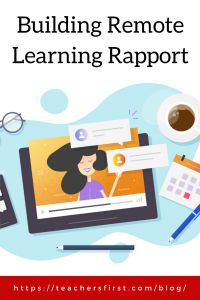 Teachers began the 2019-2020 school year with activities to build relationships with their students. Building meaningful relationships is the cornerstone of every classroom, and we work tirelessly to make connections with students and families. The COVID-19 pandemic abruptly forced teachers to transition from face-to-face learning to remote learning for the school year’s final months.
Teachers began the 2019-2020 school year with activities to build relationships with their students. Building meaningful relationships is the cornerstone of every classroom, and we work tirelessly to make connections with students and families. The COVID-19 pandemic abruptly forced teachers to transition from face-to-face learning to remote learning for the school year’s final months.
We may begin the 2020-2021 school year without meeting our students face-to-face to start the vital process of building positive relationships, a difficult but necessary step to start the school year. Educators face a new challenge during the coronavirus crisis: building rapport with their students within a digital learning space.
Relationships are more important now than ever before. We may not be teaching in a classroom where we can control the physical space to create a safe and trusting learning environment. Instead, educators must create that environment online. Connecting with students and building rapport is a crucial element of teaching both online and face-to-face. The following strategies and resources will help you establish a rapport, motivate and improve your students’ general attitude, participation, and effort.
Video Introductions
Use a screen recording tool like Screencastify (Reviewed Here) or a video tool like Animoto (Reviewed Here) to introduce yourself, convey a positive attitude, and share your personality. Flipgrid (Reviewed Here) is also a fantastic resource to establish communication and rapport with students and serves as an icebreaker to start the school year. You can also hear how the students pronounce their names and learn about their interests to help you differentiate lessons.
Availability
Students and families and often feel isolated during remote learning. Communicate office hours and schedule times to meet with students individually or in small groups. Using a tool like Adobe Spark (Reviewed Here) to send out your schedule, learning objectives, and office hours prior to the week of instruction provides students and their families an opportunity to plan their week. Students will also know the times they can connect with you.
Feedback
We provide due dates for students to complete assignments, so we must provide timely feedback on submitted assignments. Timely feedback shows students you respect their work and commitment to learning. Another strategy to enhance communication and build rapport is not to release the grade until the student responds to your feedback. It is also critical to address the students by name when providing audio, video, or typed feedback to build a respectful and caring environment. Using the student’s name in your feedback conversations give the student personalized attention.
Scavenger Hunts
Scavenger hunts are a fun introduction activity. Challenge students to locate items in their homes to assist with the remote learning experience. For example, you may ask students to find materials to use as manipulatives for math. A student may share they have straws, blocks, or LEGOS. The scavenger hunts are also a chance to get to know your students through their interests.
Surveys and Discussion Questions
Post weekly or daily prompts for the students to respond to from a site like Prompts (Reviewed Here). The student responses will help you learn something about your students’ interests, hobbies, and aspirations. Use that information to create and use personally relevant class examples. This activity will establish a rapport and respect culture, and the students will make more connections with you and the lesson experiences.
Flexibility
A critical element of connecting with students and building rapport is flexibility. Your main goal is to create an atmosphere online that enhances learning. Flexibility with deadlines establishes a culture of mutual respect and is essential to meet the students’ needs. Be flexible while getting to know your students and letting them get to know you.
Offering Choices
Providing students with choices supports flexibility and helps establish rapport. For example, allow the students to use audio, video, or text to post responses or final assignments. Providing low-tech and no-tech options during remote learning also enhances the experience for the students.
Building rapport during remote learning presents new challenges, but it’s still essential and can take on new forms online. Building rapport both online and face-to-face should be purposeful, ongoing work throughout the school year. A positive rapport with students facilitates motivation and enhances their connection with the content. How are you building rapport with your students during remote learning? We’d love to hear your strategies in the comments below!


One thought on “Building Remote Learning Rapport”